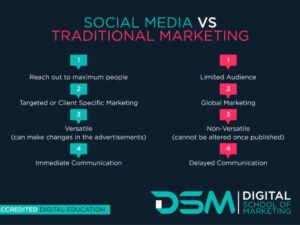[ad_1]
A Clash of Strategies: Social Media Marketing vs Traditional Marketing
In the ever-evolving world of marketing, businesses are continually exploring and implementing various strategies to reach their target audience effectively. With the proliferation of technology and the rise of social media platforms, a new player has entered the marketing landscape: social media marketing. This has sparked a clash of strategies between social media marketing and traditional marketing methods.
Traditional marketing refers to the use of traditional media channels such as television, radio, print, and billboards to promote products or services. This approach has been a cornerstone of marketing for many years, providing businesses with a reliable and proven method of reaching a broad audience. However, with the advent of social media platforms, traditional marketing has faced stiff competition.
Social media marketing, on the other hand, utilizes social media platforms like Facebook, Twitter, Instagram, and LinkedIn to promote products or services. This approach harnesses the power of social media’s vast reach and ability to engage with a highly targeted audience. It offers businesses the opportunity to interact and build relationships with consumers in a more personalized and interactive manner.

One of the key differences between these two marketing strategies is the cost involved. Traditional marketing typically requires a significant financial investment to secure airtime, ad space, or billboard placements. On the other hand, social media marketing can be relatively cost-effective, especially for small businesses with limited budgets. With a little knowledge and creativity, businesses can achieve impressive results through organic growth on social media platforms without large financial investments.
Another significant difference is the level of audience targeting. Traditional marketing often relies on mass marketing efforts, trying to reach as many people as possible in the hope that some of them will convert into customers. However, social media marketing allows for much more precise targeting. Through the use of analytics and advertising tools, businesses can narrow down their target audience based on demographics, interests, and behavior. This level of specificity helps businesses reach the right people with their marketing messages, increasing the chances of conversion.
In terms of reach and scalability, social media marketing undoubtedly has the upper hand. The number of social media users worldwide continues to grow rapidly, with billions of active daily users across various platforms. This immense potential audience provides businesses with an unprecedented opportunity to showcase their products or services to a vast number of people. Additionally, social media marketing allows for easy scalability, as businesses can quickly adjust their campaigns based on the feedback and engagement they receive.
However, traditional marketing still holds some advantages over social media marketing. For instance, television and radio advertisements can create a higher degree of brand awareness and credibility. Seeing a brand on TV or hearing it on the radio can create a sense of trust and legitimacy that social media advertisements may struggle to replicate. Similarly, print media allows for physical interaction with materials like magazines or newspapers, which can leave a lasting impression and lead to higher recall rates.
Furthermore, traditional marketing can be more effective in targeting specific demographics that may not be as prevalent on social media platforms. For example, older demographics or rural areas may still rely heavily on traditional media channels for information and entertainment. In such cases, traditional marketing methods might yield better results.
What is a safe way to insta video downloader?
In conclusion, while the clash between social media marketing and traditional marketing continues, it is evident that both approaches have their merits and limitations. Social media marketing offers a cost-effective, highly targeted, and scalable strategy, allowing businesses to engage with their audience in a personalized manner. Traditional marketing, on the other hand, provides a level of brand awareness and credibility that can be difficult to achieve through social media alone. Ultimately, the ideal marketing strategy depends on the specific goals, target audience, and budget of the business. A balanced approach that combines the strengths of both strategies might be the key to success in the dynamic world of marketing.
[ad_2]



